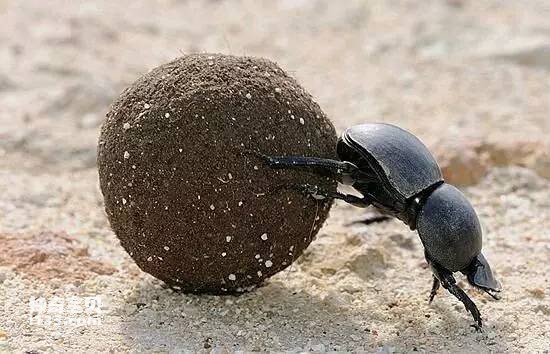There are many types of insects with diverse feeding habits, among which detritivorous insects account for 17.3% of the total number of insect species. This is also an amazing and huge group. They feed on the corpses and feces of living things. Some of them bury their corpses in the soil and become the largest "cleaners" on the earth. And because of their activities, they accelerate the decomposition of biological residues by microorganisms and play a very important role in nature's energy cycle. It's hard to imagine what the world would be like without these "sweepers" on earth! The dung beetle is an outstanding representative of them.

When you walk along country roads or visit pastoral areas, you can often find rolling dung balls. If you look carefully, you will see that it is two insects carrying "treasures" - food to satisfy hunger. Their behavior is very strange. One pulls from the front and the other pushes from behind. With each pull and push, the dung ball slowly rolls forward. It turns out this is a couple. Usually the female worm is in front and the male worm is behind, and they cooperate tacitly. That kind of scene is indeed very interesting. This clever and funny little insect is commonly known as a dung beetle or a dung beetle. It is also called a dung beetle or a cow dung beetle.
The body of the dung beetle is black or dark brown, and it is a large and medium-sized insect. The forefoot is a digging foot, the hindfoot is close to the end of the abdomen, far away from the midfoot, and the tibia of the hindfoot has an end distance. The tentacles have leaf-shaped gills, the malleus is hairy, and the small scutellum is invisible. The elytra completely cover the ventral valve. Completely perverted, nocturnal, but pushing the shit balls during the day. Burrowing underground (cave) life. It is recorded in the ancient Chinese book "Erya Wings" (written by Luo Yuan of the Song Dynasty): "The dung beetle turns the pill, one moves forward and drags it with the rear foot, and the other pushes it from behind, it is Kandi Najiu, and it will happen in a few days." Little dung beetles emerged from it." From the records in these few sentences, we can see that the author's observations are very detailed and tell us the purpose of the dung beetle pushing the dung ball. Cockroaches can make large piles of cow dung into small balls, and then push them one by one into pre-excavated holes to store and enjoy them slowly. Because the round shape saves effort when rolling on the ground, it is easier to transport it back to the nest. The female dung beetle lays her eggs in dung balls. After the eggs hatch, the baby dung beetles can get food immediately. This is the dung beetle's expression of maternal love for its children. It would rather work hard so that its children no longer have to run around looking for food after they are born. However, among the same kind of dung beetles, there are also some lazy people and scoundrels hidden. They do not work hard and often wait for the opportunity to snatch the rolling dung ball on the way, trying to take possession of it, and the two sides start a fight over it. If the "robbers" win, they will not only take away the dung balls, but also take away other people's "wives". These scoundrels are really disgusting! The dung beetle's habit of pushing dung makes it an industrious scavenger of nature. .
Dung beetles are beneficial insects and have contributed to the benefit of mankind. Australia is the world's cattle-raising kingdom. As a result, large amounts of cow dung have accumulated in mountains, destroying large amounts of grassland and breeding a large number of bacteria-carrying flies, which can spread diseases and cause disasters. Australia's native dung beetles only clean up kangaroo feces. For this reason, the Australian government has sent experts to various countries around the world to find dung beetles that can remove cow dung. In 1979, an entomologist came to China for help and introduced a unique species to China - the Shennong dung beetle. As soon as this insect arrived in Australia, it immediately joined the fight and showed its talents in clearing cow dung. The results were brilliant and successful in one fell swoop, making contributions to the local people.
animal tags: lizard
We created this article in conjunction with AI technology, then made sure it was fact-checked and edited by a Animals Top editor.